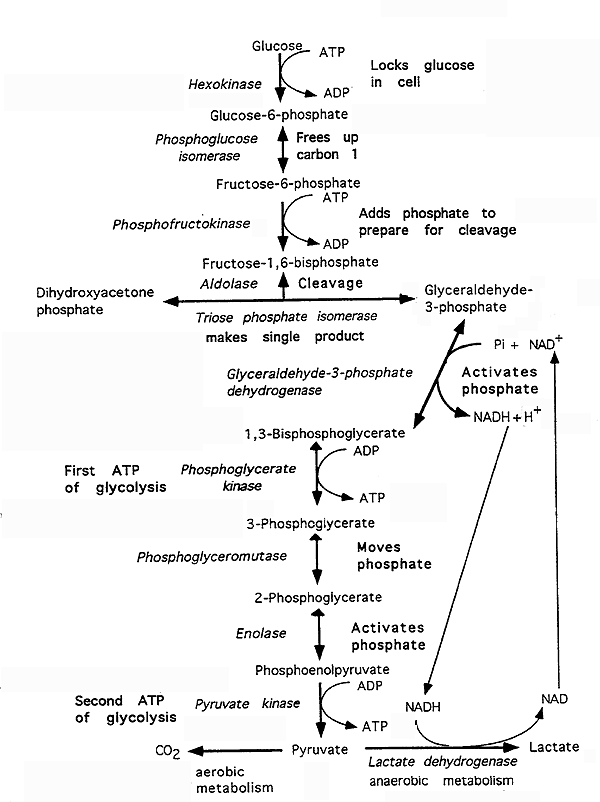
The Glycolysis Pathway:

Dehydrogenase (DH): "oxidation-reduction" reactions, look for NADH or FADH2
Kinase: "Substrate Level Phosphorylation"
Overall Pathway:
Glucose is metabolized to pyruvate.
All intermediates carry phosphate groups to lock them into the cell (stops diffusion).
Hexokinase / Glucokinase: both irreversible
Glucose + ATP ----> Glucose-6-phosphate + ADP
Hexokinase:
Catalyzes the phosphorylation of hexoses in general and is found in all cells that metabolize glucose.
Has a low Km (high affinity) so that it is active even at low glucose concentrations.
Glucokinase:
Glucose specific, found in liver.
Has a high Km (low affinity) to ensure a n appropriate response to elevation of glucose from the diet.
Phosphofructokinase-1 (PFK-1): irreversible
Fructose-6-phosphate + ATP ------> Fructose-1,6-bisphosphate + ADP
Rate-Limiting, Major Regulated Step.
Aldolase:
Fructose-1,6-bisphosphate <----> Dihydroxyacetone phosphate +Glycerladehyde-3-phosphate
Completes the first phase of glycolysis.
These trioses are interconverted by triose phosphate isomerase ------------>
To produce a single product, glyceraldehyde-3-phosphate.
Two molecules of glyceraldehyde-3-phosphate continue through glycolysis.
Glyceraldehyde-3-phosphate Dehydrogenase: Oxidation-Reduction
Glyceraldehyde-3-phosphate + NAD+ + Pi <---> 1,3-Bisphosphoglycerate + NADH
NADH formed must be reoxidized to regenerate NAD+ to sustain glycolysis.
Energy released from this reaction is conserved as a high energy phosphate bond in 1,3-bisphosphoglycerate.
Inorganic phosphate, rather than ATP, provides the source of the phosphoryl group.
Aerobic Conditions:
Mitochondrial systems oxidize NADH and produce ATP.
Phosphoglycerate Kinase: "Substrate Level Phosphorylation"
1,3-bisphosphoglycerate + ADP <----> 3-phosphoglycerate + ATP
1,3-Bisphosphoglycerate is a high energy intermediate that drives the phosphorylation of ADP to ATP.
Remember: Two molecules are proceeding through glycolysis, so 2 ATP.
Pyruvate Kinase: "Substrate Level Phosphorylation"
Phosphoenolpyruvate + ADP -------> Pyruvate + ATP
Irreversible, Highly Regulated.
Produce 2 ATP.
Lactate Dehydrogenase: "Anaerobic"
Pyruvate + NADH ----> Lactate + NAD+
This step regenerates NAD+ for glyceraldehyde-3-phosphate dehydrogenase or glycolysis would STOP.
H4: heart isozyme, high affinity for lactate (low Km), allosterically inhibited by pyruvate.
When pyruvate is high oxidizes to Acetyl CoA.
M4: muscle isozyme, produces lactate in muscle when pyruvate is high.
Energy Yield:
Anaerobic (i.e. RBC): Pyruvate ---> Lactate, 2 ATP per glucose molecule.
Aerobic: Mitochondrial oxidation of NADH via electron transfer shuttles.
NADH ----> 2 ATP, a-glycerol phosphate shuttle (4 ATP per glucose)
NADH ----> 3 ATP, malate-aspartate shuttle (6 ATP per glucose)
Fructose Metabolism:
Occurs in liver.
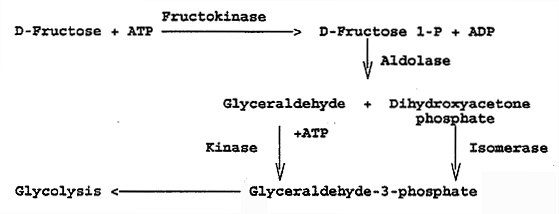
Galactose Metabolism:
Occurs in liver.
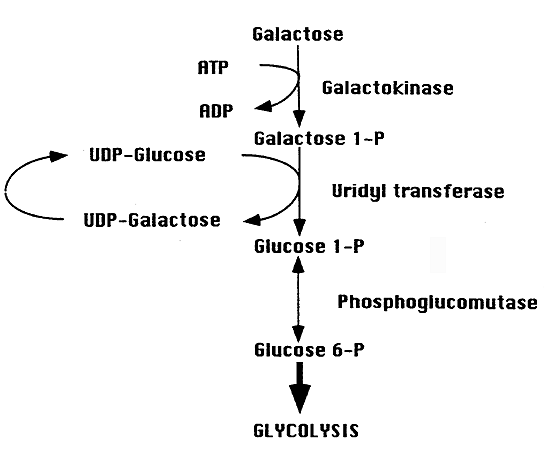
UDP-Glucose is an activated form of glucose found as an intermediate in glycogen formation.
UDP-Glucose is recycled from UDP-Galactose thus, there is no NET change in concentration of this compound.
Fructose and Galactose Energy Production: still 2 ATP.
(Fructose enters at glyceraldehyde-3-phosphate)
(Galactose enters at glucose-6-phosphate)
Gluconeogenesis:
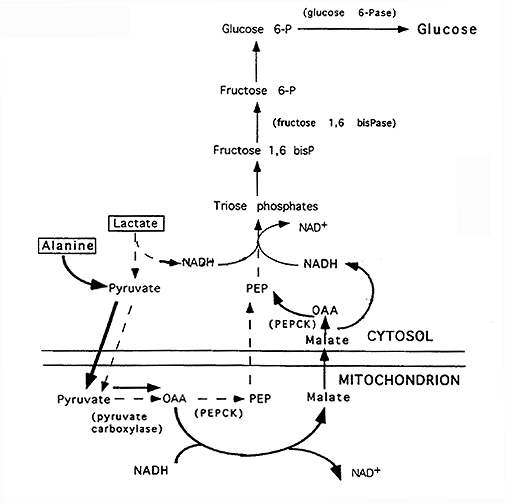
Pyruvate Carboxylase: Pyruvate ---------> OAA
Requires biotin as a prosthetic group to carry CO2.
Requires ATP.
Activated: by acetyl CoA in concert with the inhibition of Pyruvate DH (PDH).
Phosphoenolpyruvate Carboxykinase (PEPCK): OAA ------------> PEP
"Rate -Limiting", commited step.
Requires GTP.
Induced during starvation.
Fructose 1,6-bisphosphatase: (Fructose-1,6-bisphosphate ------> Fructose-6-phosphate + Pi)
Can form a futile cycle with phosphofructokinase-1 (PFK-1)
Fructose-6-phosphate + ATP ------> Fructose-1,6-bisphosphate + ADP
The two enzymes are reciprocally regulated or ATP would be lost without energy conservation.
Glucose-6-Phosphatase: (Glucose-6-phosphate ------> Glucose)
Can form a second futile cycle with hexokinase/glucokinase
Glucose + ATP --------> Glucose-6-phosphate + ADP
The two enzymes are reciprocally regulated or ATP would be lost without energy conservation.
Unique to tissues producing glucose, i.e. liver and kidney.
Glucose-6-phosphate produced from the gluconeogenic pathway is transported to the ER for dephosphorylation.
Glucose and Pi are returned to the cytosol.
Glucose is exported to the blood and Pi remains in the cell.
Lactate as a Precursor: ~40% contribution
Derived from RBC's or from muscle during exercise.
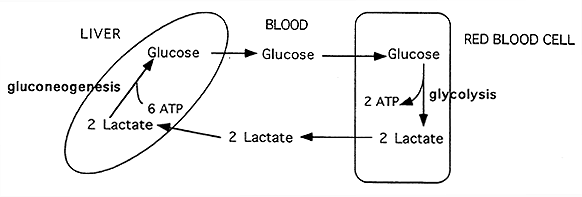
Shows an interrelationship between liver and RBC's.
This cycle provides a means for localized ATP production. However, as a consequence of gluconeogenesis there is an overall NET LOSS of ATP in the body.
Alanine as a Precursor: ~25% contribution
Alanine is converted to pyruvate via alanine aminotransferase.
The Alanine Cycle (Glucose-Alanine Cycle):
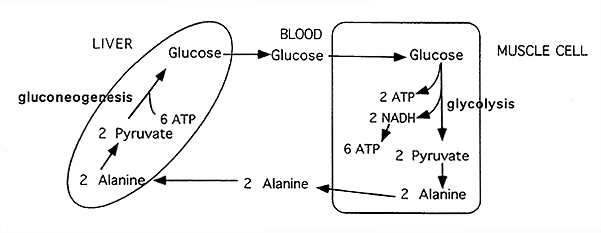
Shows an interrelationship between liver and muscle.
Again, this cycle provides a means for localized ATP production. However, as a consequence of gluconeogenesis there is an overall NET LOSS of ATP in the body.
Glycerol as a Precursor: ~10% contribution
Produced from the breakdown of triacylglycerols in adipose tissue.
Glycerol ------> -------> DHAP, involves only enzymatic reactions in the cytosol.
Pentose Phosphate Pathway:
-Source of NADPH (reductive synthesis, maintainence of glutathione in the reduced state), pentoses for nucleic acid synthesis, interconversion of pentoses with hexoses and trioses.
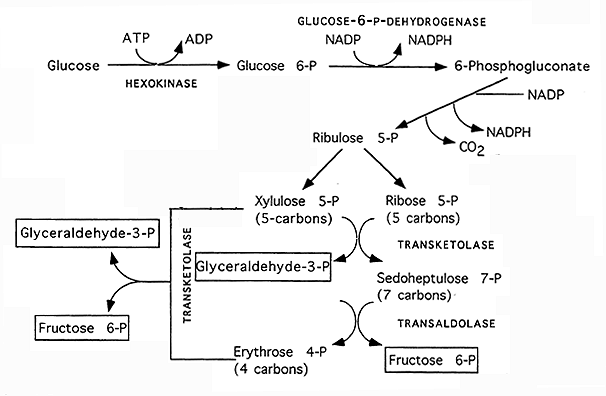
Oxidative Branch:
Glucose-6-phosphate ----> 6-Phosphogluconate ----> Ribulose-5-phosphate ----> Ribose-5-phosphate
Produces: 2 NADPH
Non-Oxidative Branch:
Ribose-5-phosphate ----> ----> Glyceraldehyde-3-phosphate + Fructose-6-phosphate
Produces:
Ribose-5-phosphate for nucleic acid synthesis.
Interconverts pentoses, hexoses and trioses.
Meeting Cellular Needs:
[1] When the requirement for Ribose-5-phosphate exceeds the need for NADPH
(a) Non-Oxidative Branch: reversed to produce Ribose-5-phosphate (nucleic acid precursor)
(b) Oxidative Branch: shut-down, no NADPH production
[2] When the requirement for NADPH exceeds the need for Ribose-5-phosphate
(a) Oxidative Branch: will be activated
(b) Non-Oxidative Branch: Ribose-5-phosphate will be converted to Glyceraldehyde-3- phosphate and Fructose-6-phosphate which will enter the glycolytic pathway for metabolism to pyruvate (this eliminates "feedback" inhibition by Ribose-5- phosphate which would inactivate the Oxidative Branch).
[3] When a balanced requirement for NADPH and Ribose-5-phosphate must be met
(a) Oxidative Branch: activated
(b) Non-Oxidative Branch: inactivated (Ribose-5-phosphate is not metabolized)
Glutathione: Tripeptide (Glu-Cys-Gly)
Glutathione Reduced: Glu-Cys(SH)-Gly
Glutathione Oxidized:
Glu-Cys-Gly
Glu-Cys-Gly
Glutathione Reductase:
Glutathioneoxidized + NADPH + H+ ----------------> 2 Glutathionereduced + NADP+
Contains bound FAD which it uses to transfer electrons from NADPH to Glutathioneoxidized
Glutathione Peroxidase:
2 Glutathionereduced + H2O2 ---------------------> Glutathioneoxidized + 2 H2O
Glutathionereduced: removes peroxides maintaining RBC membrane integrity and preventing hemolytic anemia.
© Dr. Noel Sturm 2021